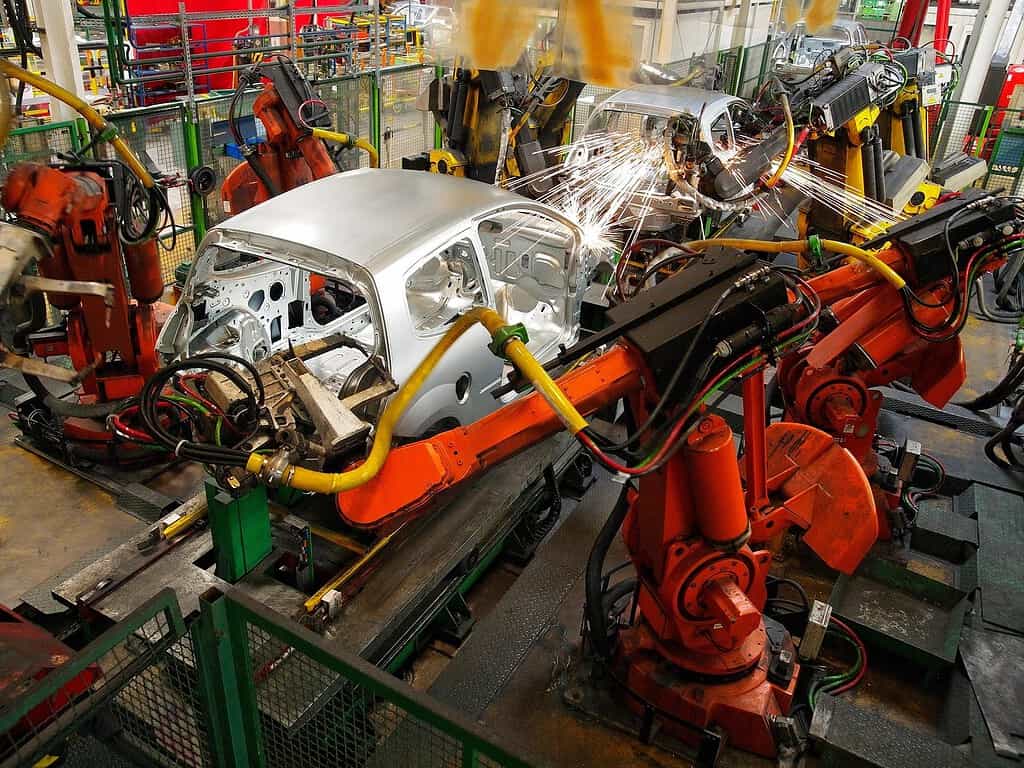It’s no secret that the world has changed drastically in the last few years. Customer and stakeholder priorities are shifting, and companies are being forced to rethink their approach to sustainable, eco-friendly production. All the while, companies are facing new and evolving challenges, linked to everything from energy consumption, to supply chain issues and economic uncertainty.
McKinsey, one of the world’s largest analytical and technology companies, published a report in 2022, outlining the state of the “manufacturing renaissance” in the United States. This study looked at the changing manufacturing economy post-COVID, highlighting the growing importance of “transformation” among organizations.
More recently, 8×8’s Peter Milligan evaluated this report in a blog of his own. In this article, Milligan noted that as manufacturing companies embrace the new “renaissance”, they’ll also need to reconsider their approach to customer service, and the contact centre.
Today, we’re reviewing some of the most important points 8×8 believes manufacturing companies will need to address as we move into the years ahead.

Point 1: The Growing Demand for Sustainability
Earning customer loyalty and boosting retention rates now requires companies to invest in delivering more than just an exceptional product or service. Consumers in every industry expect organizations to not only deliver timely, personalized support on every channel, but also demonstrate a commitment to key values and priorities, such as sustainability and greenIT initiatives.
To connect with consumers, remain compliant with changing regulations, and stay ahead of shifting trends, many companies are going all-in with their CSR and ESG initiatives. In fact, around 88% of companies now have their own ESG initiative, as of 2020.
Even manufacturing companies, that have long relied on fossil fuels and legacy processes are looking for ways to minimize waste and emissions. However, as Milligan notes in his review, sustainability needs to apply to all of a manufacturing company’s processes.
It’s not enough to simply use eco-friendly materials and renewable energy in your production plants. You also need to think about the sustainability of your customer service teams and contact centre.
Accessing Sustainability in the Contact Centre
As Milligan notes, the natural transformation of the contact centre since the pandemic is already pushing many companies towards more sustainable practices. During the pandemic, many organizations were forced to embrace cloud-based technologies, empowering agents to work from anywhere, when access to the office wasn’t available.
The shift to remote and flexible work has been extremely impactful from a sustainability perspective. For instance, a FlexJobs survey found that people working from home will save around $432 per year on petrol, and significantly reduce their carbon emissions, thanks to fewer commutes.
Additionally, the shift to remote work has had a number of other benefits for companies and employees alike. It has increased the number of jobs available to team members, and offered greater work-life balance to people from various environments.

Cloud based solutions are allowing employees to reduce travel whilst maintaining high performance levels. They’re also helping companies to cut down on the amount of on-site maintenance and support they need for contact centre technologies. A reduced need for on-site support doesn’t just save companies time, and money, it also means fewer people need to commute to a specific location each day.
While the cloud contact centre doesn’t eliminate every sustainability problem businesses face, it does reduce the consumption of petrol and other travel related carbon emissions in many businesses, and help pave the way for greener operations.
Point 2: Digital Transformation in the Contact Centre
McKinsey’s study highlights a growing need for digital transformation throughout the manufacturing sector. In 2022, the US manufacturing space had reached an inflection point, according to the report. The growth of the sector was diminishing, and the number of firms in the region had begun to shut down, due to the wide range of issues facing the landscape.
However, McKinsey believes that investing in the digital transformation of these companies will have transformative economic and social effects. In fact, restoring growth in the manufacturing space could boost US GDP by over 15% through to 2030.
While there are certainly various ways to “digitally transform” manufacturing spaces, leveraging tools like AI, automation, and the internet of things, Milligan drew attention to the benefits of upgrading the contact centre in his blog post.
According to him, digital transformation has been a consistent trend in the contact centre landscape for some time now. However, not all companies in the manufacturing space have kept up with the latest trends. The manufacturers that apply digital technologies to their operations at scale, according to the blog, are the ones that drive genuine KPI improvements, not just in terms of productivity, but also in connection to sustainability, agility, and speed to market.
The Power of Digital Transformation in the Contact Centre

From a sustainability perspective, we’ve already noted examples of how digital transformation can help contact centres and manufacturing companies become more eco-friendly. Embracing sustainable IT practices, and eco-friendly cloud technologies significantly reduces carbon emissions, waste, and other issues that harm our landscape.
Milligan notes that adopting digital channels in a contact centre also helps companies to differentiate themselves, and maintain a competitive edge in an unpredictable environment.
Adopting digital channels and unique service solutions through cloud-based platforms means manufacturing teams can begin to deliver more customized, personalized, and convenient experiences to customers and suppliers. An omnichannel platform, like the 8×8 contact centre allows users to choose the channels they want to use to engage with your business.
This makes it easier for customers to communicate efficiently with your organization, and ensures you can build stronger, longer-lasting relationships with stakeholders. Milligan says adopting digital channels alone can be enough to improve CSAT, NPS, and FCS scores, while also adding to revenue production and productivity. What’s more, McKinsey agrees that an investment in digital transformation for customer experience can increase company revenue by 20-50%.
Point 3: Reskilling and Upskilling Agents
McKinsey’s report on the manufacturing renaissance notes the adoption of new tools, and an increased focus on new priorities, like sustainability, will drive a demand for new skill sets in the manufacturing landscape. Unfortunately, skill shortages are already rampant in the industry.
In 2023, studies found that 36% of vacancies in manufacturing are proving difficult, or very difficult to fill. While embracing cloud-based tools for employees and contact centre workers can help businesses target a wider talent pool, through remote working opportunities, business leaders will struggle to fill their teams with new talent alone.
McKinsey and Milligan note that businesses will need to take a multi-faceted approach to addressing skill gaps in their workforce, focusing on not only hiring new team members, but reskilling and upskilling their existing employees.
Overcoming Skill Gaps in the Contact Centre
8×8 and Milligan believe companies in all industries, including the manufacturing sector, will need to invest more time and effort into coaching and training their existing agents. Fortunately, there are various tools in the cloud contact centre landscape that can support this process.
Quality management software and analytical tools can provide businesses with a direct insights into where training and development opportunities are necessary. What’s more, they can help companies to offer guidance to their employees wherever they are, with real-time coaching, AI-powered guidance, and flexible training sessions.

Milligan also notes companies that want to survive and thrive following the manufacturing renaissance will need to look for new ways to keep agents motivated. This could mean introducing new company-wide recognition programs, bonuses, awards, and even gamified competitions.
Investing in the continued development of your team members doesn’t just ensure you can adapt rapidly to the changes in the marketplace. It also helps companies to avoid issues with expensive turnover.
According to the SQM group, each lost agent in a contact centre costs a company around $20,800. Investing in training your existing agents, instead of replacing them makes more sense financially. It also has a direct impact on your brand’s reputation, and your company’s ability to serve customers. Happier, more productive agents, lead to more satisfied customers.
Maintaining Resiliency in the Manufacturing Industry
Alongside outlining the three points above, Milligan also drew attention to the importance of maintaining resiliency in the new age of manufacturing. Downtime in any industry can have a devastating effect on your company’s profits and performance.
For manufacturers, disruptions in supply chains, external and internal communications, and other problems can impact the health of the entire business. As such, businesses need to ensure they’re building resiliency into their plans for future growth.
From a contact centre perspective, this means looking for a vendor of cloud-based and agile solutions that can guarantee consistent uptime. The best vendors will offer redundant solutions that allow you to switch traffic between systems and locations, without missing out on crucial interactions. This requires providers to have multiple data centres located around the world.
If you want to combine your quest for resiliency with your goals for sustainability, then looking for a provider who also leverages state-of-the-art technology to minimize emissions and make data centres more efficient will also be crucial. You can access guidance on the importance of sustainable data management here on the SaaSCom blog.
Looking to the Future of Manufacturing

Ultimately, the manufacturing industry, just like many other sectors in the modern world, is experiencing a period of rapid change. Ensuring you can survive and thrive in the new landscape means investing in the right technologies, priorities, and people to power business growth.
A comprehensive plan for upgrading not just your manufacturing processes, but your approach to customer service and contact centre experiences has a direct impact on your company’s performance. With the right technologies and partners, you can improve customer satisfaction rates, increase profitability, and reduce your impact on the planet, all at the same time.
Are you ready for the manufacturing renaissance?



